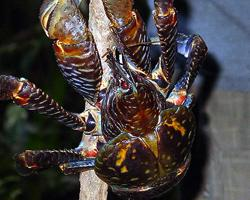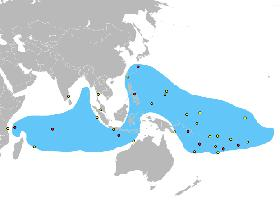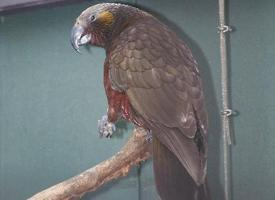
Súlyok és méretek
| Hossz | 40 cm |
|---|
Veszélyeztetettség
| Veszélyeztetett |
Állatleírás
The Coconut Crab (Birgus latro), often heralded as the largest terrestrial arthropod in the world, is a remarkable creature that captures the imagination with its size, strength, and unique lifestyle. This fascinating species is a type of hermit crab that has adapted to a life mostly on land, showcasing a set of extraordinary characteristics that distinguish it from its marine relatives.Physical Description:
The Coconut Crab is an imposing figure, with adults typically reaching up to 1 meter (3 feet) in leg span and weighing up to 4 kilograms (9 pounds), although larger specimens have been reported. Its robust body is protected by a hard exoskeleton that comes in shades of blue, red, or a mix of both, helping it blend into its natural surroundings. Unlike other crabs, the Coconut Crab's abdomen is fully armored, and as it grows, it does not need to seek out larger shells for protection. This crab possesses powerful claws that can lift objects up to 29 kg (64 pounds) in weight, and these claws are also capable of cracking open coconuts, which is a feat that contributes to its name.
Habitat and Distribution:
Coconut Crabs are found across the Indo-Pacific region, inhabiting islands from the Indian Ocean to the central Pacific Ocean. They favor coastal forests, gardens, and palm plantations where they can find shelter during the day. Despite their aquatic larval stage, adult Coconut Crabs are primarily terrestrial, only returning to the sea to release their eggs.
Diet and Behavior:
These crabs are omnivores with a diet that includes fruits, nuts, seeds, and the pith of fallen trees, but they are particularly renowned for their ability to crack open coconuts with their powerful claws. They are also known to eat carrion and other organic matter, showcasing their opportunistic feeding habits. Coconut Crabs are mostly nocturnal, spending their days hidden in burrows or rock crevices to conserve moisture and coming out at night to feed and mate.
Reproduction:
The reproductive process of the Coconut Crab begins with a courtship that involves the male and female engaging in a mating dance. After mating, the female carries the fertilized eggs attached to her abdomen until they are ready to hatch. She then migrates to the ocean's edge, releasing the larvae into the water, where they will go through several planktonic stages before settling on the ocean floor, undergoing a metamorphosis, and starting their terrestrial life.
Conservation Status:
The Coconut Crab is considered to be under threat in several parts of its range due to habitat loss, predation by introduced species, and overharvesting by humans, both for food and as a curiosity. While it is not currently listed as endangered, its population is believed to be in decline, prompting conservation efforts in some areas to protect this unique species.
Cultural Significance:
In many of the cultures where they are found, Coconut Crabs are considered a delicacy, and their harvesting is often surrounded by traditional practices. However, their impressive appearance and unique behaviors have also made them a subject of interest and fascination around the world, contributing to their appeal as a symbol of the exotic and diverse wildlife found on tropical islands.
In conclusion, the Coconut Crab is an extraordinary creature that stands out not only for its size and strength but also for its intriguing lifestyle and adaptations to terrestrial life. Its presence enriches the biodiversity of the regions it inhabits, and efforts to conserve it are vital for maintaining the ecological balance and cultural heritage of these areas.
Előfordulási térkép

Hasonló állatok
Új állatfotók
Top 10 állat
- Dolphin gull (Leucophaeus scoresbii)
- Diana monkey (Cercopithecus diana)
- Japanese macaque (Macaca fuscata)
- Stone loach (Barbatula barbatula)
- Galápagos tortoise (Geochelone nigra complex)
- Moustached guenon (Cercopithecus cephus)
- Russian tortoise (Testudo horsfieldii)
- Common house mosquito (Culex pipiens)
- Japanese spider crab (Macrocheira kaempferi)
- Giant peacock moth (Saturnia pyri)


